The overall fisheries production in Region I registered positive growth in 3rd quarter 2017. From the total output of 24,599 metric tons in 3rd quarter 2016, it grew to 24,800 metric tons this 3rd quarter 2017. All the provinces posted increases in output, except La Union.
All three fisheries sub-sectors registered gains in output. The aquaculture sub-sector contributed 76.6 percent to the total fisheries production of Region I in 3rd quarter 2017. The municipal and commercial sub-sectors accounted 18.4 percent and 5.0 percent, respectively.
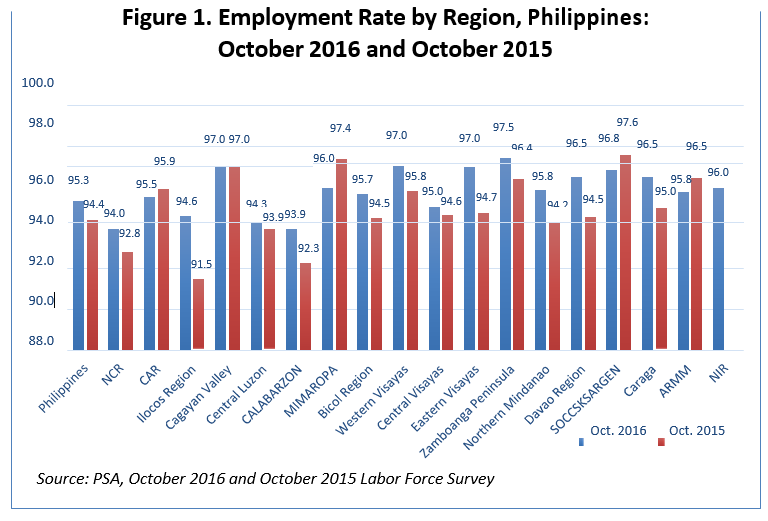
In terms of provincial distribution, the province of Pangasinan shared the bulk of production of about 83.3 percent in 3rd quarter 2017. All the three fisheries sub-sectors of the province registered higher production as compared to its respective level in 3rd quarter 2016. The total fishery output of the province increased from 20,599 metric tons to 20,670 metric tons.
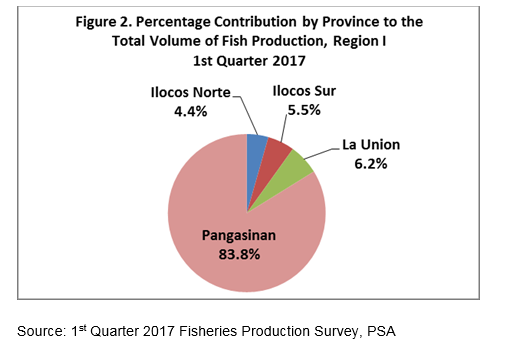

The province of La Union registered lower overall fisheries production in 3rd quarter 2017 as compared in its 3rd quarter 2016 level contributed by the decline in output of municipal fisheries. Total fisheries production of the province was posted at 1,535 metric tons, lower than the 1,588 metric tons output in the same period of 2016. La Union accounted 6.2 percent to the overall fisheries production of Region I in 3rd quarter 2017.
The fisheries production of Ilocos Sur, which shared 5.3 percent to the total fisheries output of the region, registered positive growth in 3rd quarter 2017. Its production during the period was 1,312 metric tons, higher than the output of 1,208 metric tons in 3rd quarter 2016. All the fisheries sub-sectors of the province posted increases in output.
The province of Ilocos Norte, which shared 5.2 percent to the total fisheries production of Region I, went up by 6.5 percent in 3rd quarter 2017. Its output was posted at 1,282 metric tons, higher than the output in the same period in 2016 of 1,204 metric tons. The municipal fisheries contributed to the overall positive growth in the fisheries output of the province.
Commercial Fisheries
The commercial fisheries volume of production in Region I increased by 1.7 percent in 3rd quarter 2017. Its output was posted at 1,238 metric tons, higher than the output in the same period of 2016 of 1,218 metric tons. All the provinces posted higher output. More fishing trips, and increased fishing vessels in operation were observed due to lesser weather disturbances. Also, more harvest from payaos and artificial reefs, presence of school of fish, and bigger sizes of catch were noted.
In terms of provincial shares, Pangasinan accounted for 83.4 percent of the region’s commercial fisheries volume of production in 3rd quarter 2017. It was followed by La Union at 9.9 percent share, and Ilocos Sur at 6.6 percent share.
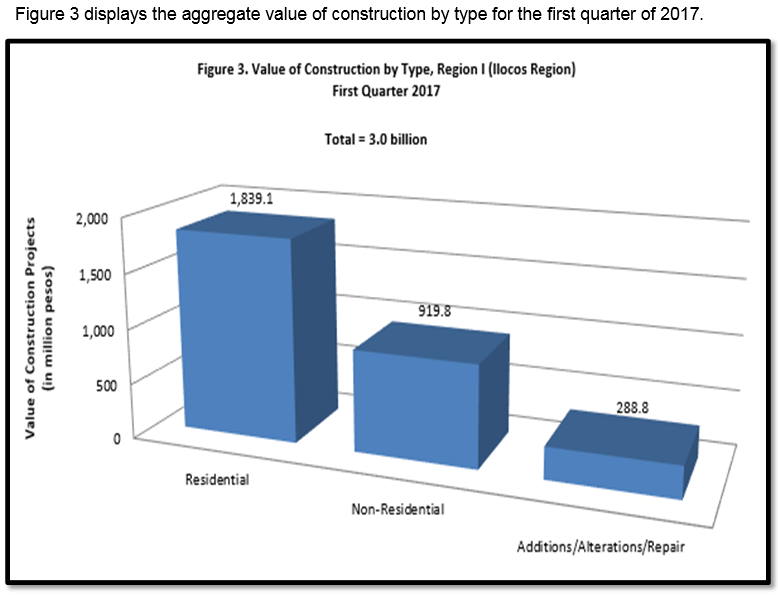
The top five major catch in the region during the 3rd quarter 2017 were Roundscad, Skipjack, Frigate tuna, Yellowfin tuna, and Indian mackerel.
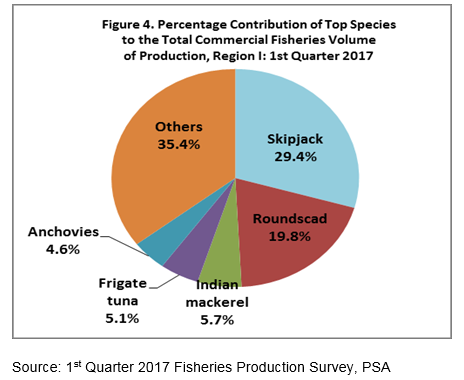
Municipal Fisheries
The overall municipal fisheries production of Region I in 3rd quarter of 2017 grew by 3.1 percent. The overall production was posted at 4,557 metric tons, higher than the output in 3rd quarter 2016 of 4,422 metric tons. Increased catch in the marine municipal contributed to the overall gains in output of the sub-sector.
Marine Municipal
Production of Marine Municipal Fisheries in Region I in 3rd quarter 2017 was posted at 4,118 metric tons, higher than the output in 3rd quarter 2016 of 3,964 metric tons. All the provinces of the region posted increment in output. More fishing operations, bigger sizes of catch, presence of school of fish, and more harvest from payaos and artificial reefs were noted as the factors that contributed to the overall growth of the sub-sector. Also, more fishermen were encouraged to go fishing due to more catch and lesser destructive typhoons.
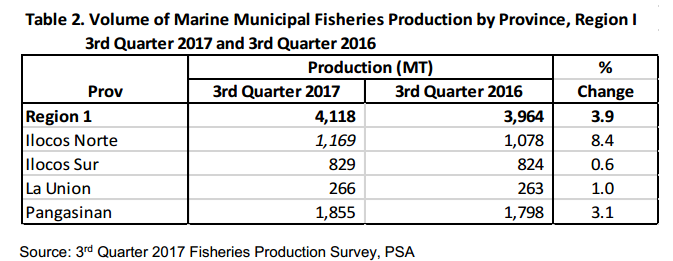
The province of Pangasinan contributed 45.0 percent to the region’s marine municipal fish catch for the 3rd quarter 2017, followed by Ilocos Norte with 28.4 percent share, Ilocos Sur with 20.1 percent share, and La Union with 6.5 percent. The dominant catch in marine municipal waters of Region I during the period were Roundscad, Yellowfin tuna, Skipjack, Squid, and Flying fish.
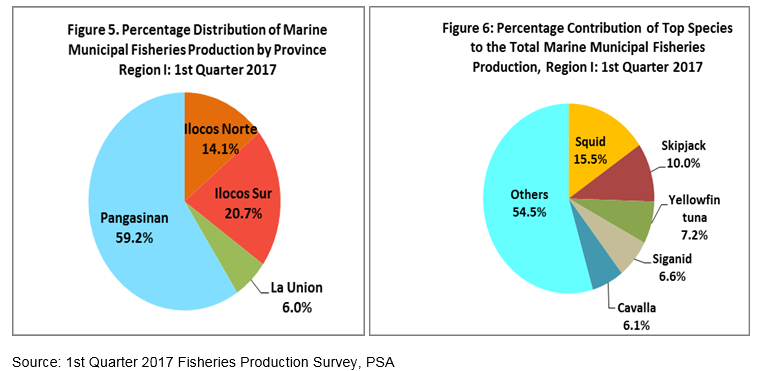
Inland Municipal Fisheries
Production of Inland Municipal Fisheries in Region I decreased by 4.2 percent in 3rd quarter 201. From its output of 458 metric tons in the same period last year, it declined to 439 metric tons this year. All the provinces, except Ilocos Sur, posted lower growths. Lesser fishing operations, shifting to other source of income like marine and aquaculture operations, and construction works, and smaller sizes of catch may have contributed to the overall decrement in output.
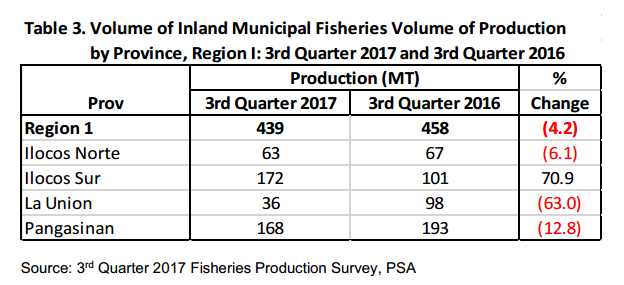
By province, Ilocos Sur ranked first in the volume of production of Inland municipal fisheries during the 3rd quarter 2017 with 39.2 percent share. It was followed by Pangasinan with 38.4 percent share, Ilocos Norte with 14.2 percent, and La Union with 8.2 percent. The top five major catch in the region during the period were Tilapia, Freshwater goby, Endeavor prawn, White shrimp, and Freshwater crab.
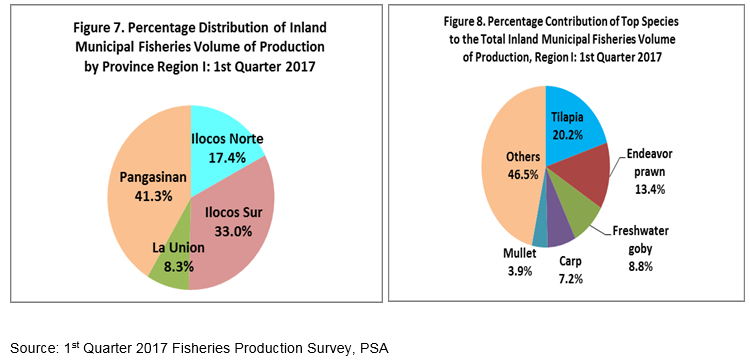
Aquaculture
Aquaculture production of Region I increased by 0.24 percent in 3rd quarter 2017. From its output of 18,960 metric tons in the same period last year, it went up to 19,004 metric tons this year. All the provinces of the region, except Ilocos Norte, posted positive growths in output. The overall increment in production could be attributed to higher stocking rate due to availability of fingerlings, higher survival rate, bigger sizes of harvest, good feeding management, and lesser destructive typhoons.
The province of Pangasinan shared the bulk of aquaculture production with 92.7 percent. By culture type, aquaculture in Region I was dominated by Marine cage which accounted for 44.4 percent of the total production.
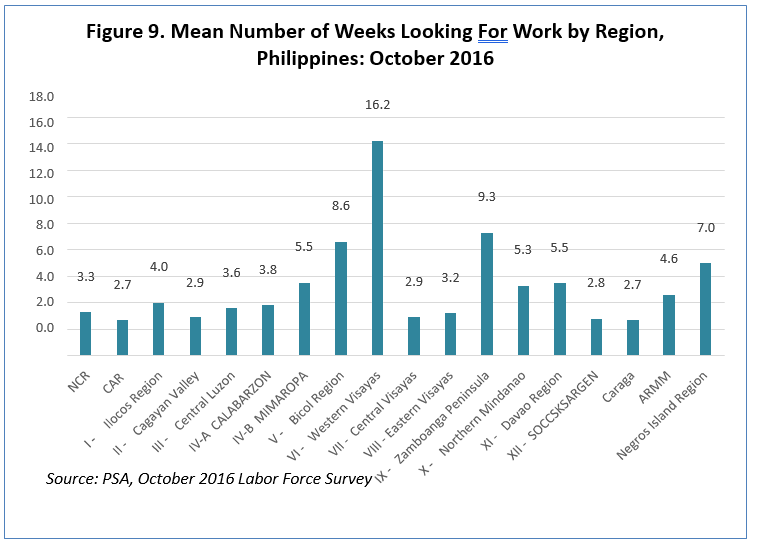

Milkfish dominated the aquaculture production of Region I with a share of 93.4 percent. Its production in 3rd quarter 2017 was posted at 17,744 metric tons, higher than its output in the same quarter last year of 17,592 metric tons. Higher stocking rate due to availability of quality fingerlings, higher survival rate, bigger sizes of harvest, and good feeding management were the factors that contributed to the higher production.
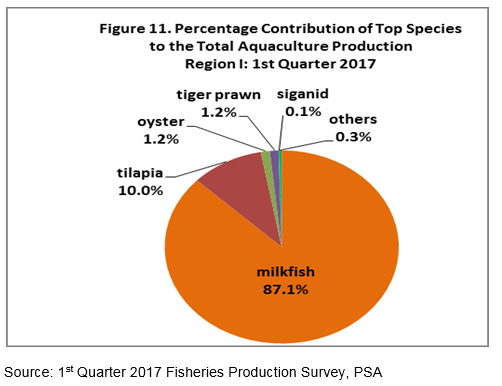
Among the provinces of Region I, Pangasinan has the bulk of milkfish production in 3rd quarter 2017. It shared 94.9 percent to the total production of the region. The rest were shared by the other three provinces.

TECHNICAL NOTES
The Fisheries Production Survey of the Philippine Statistics Authority (PSA) is divided into four (4) major fisheries surveys. These are the Quarterly Commercial Fisheries Survey (QCFS), Quarterly Municipal Fisheries Survey (QMFS), Quarterly Inland Fisheries Survey (QIFS) and Quarterly Aquaculture Survey (QAqS). The commercial and municipal fisheries surveys aim to provide quarterly data on volume and value of fish production by species, by region and by province. The aquaculture survey is intended to generate quarterly data on volume and value of cultured species by environment, by type of aquafarm, by region and by province.
Concepts and Definitions:
Aquaculture – fishery operation involving all forms of raising and culturing of fish and other fishery species in marine, brackish and fresh water environment. Examples are fishponds, fish pens, fish cages, mussel, oyster, seaweed farms and hatcheries.
Aquafarm – the farming facilities used in the culture or propagation of aquatic species including fish, mollusk, crustaceans and aquatic plants for purposes of rearing to enhance production.
Brackishwater – mixture of seawater and freshwater with salinity that varies with the tide.Example are estuaries, mangroves and mouths of rivers where seawater enters during high tide.
Commercial Fishing – the catching of fish with the use of fishing boats with a capacity of more than three (3) gross tons for trade, business or profit beyond subsistence or sports fishing.
Fisheries – all activities relating to the act or business of fishing, culturing, preserving, processing, marketing, developing, conserving and managing aquatic resources and the fishery areas including the privilege to fish or take aquatic resources thereof (RA 8550).
Fisheries Sector – the sector engaged in the production, growing, harvesting, processing, marketing, developing, conserving and managing of aquatic resources and fishing areas.
Fish Cage – stationary or floating fish enclosure made of synthetic net wire/bamboo screen or other materials set in the form of inverted mosquito net (“hapa” type) with or without cover with all sides either tied to poles staked to the water bottom or with anchored floats for aquaculture purposes.
Fishing Gear – any instrument or device and its accessories utilized in taking fish and other fishery species.
Fishing Grounds – areas in any body of water where fish and other aquatic resources congregate and become target of capture.
Fish Pen – an artificial enclosure constructed within a body of water for culturing fish and fishery/ aquatic resources made up of bamboo poles closely arranged in an enclosure with wooden materials, screen or nylon netting to prevent escape of fish.
Fishpond – a body of water (artificial or natural) where fish and other aquatic products are cultured, raised or cultivated under controlled conditions. This is a land-based type of aquafarm. Note that the setting-up of fish cages in ponds does not make the operation of fish cage and at the same time a fishpond.
Freshwater – water without salt or marine origin, such as generally found in lakes, rivers, canals, dams, reservoirs, paddy fields and swamps.
Inland Municipal Fishing – the catching of fish, crustaceans, mollusks and all other aquatic animals and plants in inland water like lakes, rivers, dams, marshes, etc. using simple gears and fishing boats some of which are non-motorized with a capacity of three (3) gross tons or less; or fishing not requiring the use of fishing boats.
Landing Center – place where the fish catch and other aquatic products are unloaded and traded.
Municipal Fishing – covers fishing operation carried out with or without the use of a boat weighing three (3) gross tons or less.
SGD. SOCRATES L. RAMORES
Regional Director

